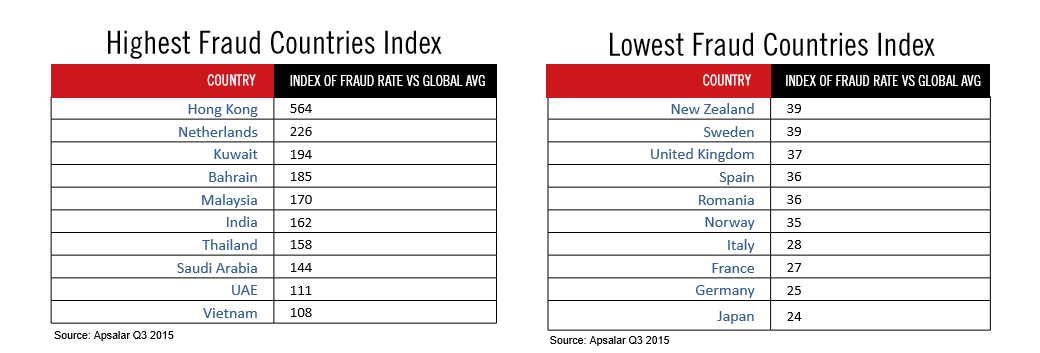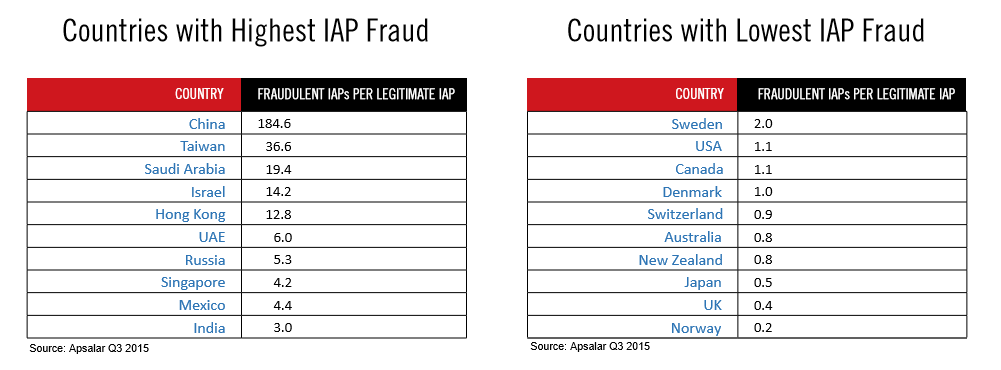As smartphones penetrate deeper into people’s lives and interaction time with apps increases, the ugly head of hacks and frauds has reared itself in this budding industry. With a mad rush to capture the market, companies and industries are looking to try and get as many customers as they can target, as fast as possible. Inexperienced in this new field with deep wallets in tow, the new entrants in the app market are the perfect targets of fraudsters and shady ad networks. Increasing rapidly at a rate of 22% globally, over the last quarter (Q3 2015), click fraud is a serious threat to the app industry that many are still in the dark about.
In a recent report by Apsalar, it has been found that globally, for every legitimate click to install an app, there are 3.13 fraudulent clicks, an alarming statistic to say the least. While mature markets like the US, have been less affected, the ones most plagued by click frauds are the countries that have shown a rapid increase in the app ecosystem in Q3. However, it’s not just app installs that are being faked; in-app transactions are not safe either. With revenue from games hitting $91.5 billion in 2015, fraudsters have turned their attention to this market as well. Today we take an in-depth look at this major problem of the app industry and try to analyse the cause, the effect and ultimately the remedy to these criminal activities.
App Fraud: A Global Criminal Network
A quick look at the two lists will give us a fair idea that ad frauds are prevalent in mostly the Asia/Middle Eastern countries, although new entrant Netherland has the ignominious honour of representing Europe. App fraud is also consistent as 7 of the top 10 featured in the list for Q2 2015 as well with the Netherlands, Thailand and UAE are the new members.
Europe except for the Netherlands performed admirably as they had some of the lowest fraud rates worldwide. Japan was a shining point in Asia as it managed to edge out Germany to the spot for the lowest number of fraud app installs. Areas of Latin America and the Philippines have lower rates of app frauds as well, but it may increase as OEMs look to push into these emerging smartphone markets.
While the increasing rate of fraud is apparent in the evolving smartphone markets, one of the few bright points is that markets reaching a semblance of maturity like India have actually shown an 18% decline QoQ. This is one of the few positives to emerge from this report as this shows that the app boom in India is sustainable and can combat against such frauds.
In-App Purchase Thefts Threatens To Topple The Freemium Model
It is no fluke that games are at the top of the revenue tree in both Android and Apple App stores. The freemium models of games such as Clash of Clans and Candy Crush Saga have pushed them to the height of success. Although the business practice of forcing people to dole out money to progress can be called into question, pay to play has no doubt proven itself as king of the hill in the modern smartphone-centric world.
Due to a variety of reasons, IAPs and hitherto IAP frauds have escaped under the noses of analysts and advertisers alike. But as 2015 draws to a close and mobile gaming threatens to overtake other forms of gaming, one has to sit up and take notice. Overall, this quarter has seen the IAP thefts slow down at a rate of 26% QoQ. The numbers are impressive at first glance, but the overall rate of IAP theft stands at 5.6, a reminder of how large this problem is and how little has been done to alleviate it.
Here we see a slightly different scenario than with Ad frauds. The reason being is that the markets being targeted here are where companies have managed to gain a fair chunk of the audience and are now looking to monetize their user base. This is why we see China, the largest smartphone market right now grabs the top spot. Saturated markets like the US, have more stringent measures and hence enjoy the benefits of lower IAP thefts.
Like with most scamming schemes, IAP theft originates from the lack of knowledge and proper implementation of security measures in apps. This is why markets that have higher rates of smartphone penetration for a long time have lower rates as developers of a mature market are more acutely aware of these problems. This forms the perfect segway to the last part of our article, where we are discussing the preventive measures available to companies right now.
The Way Forward For App Publishers
There is a lot of misinformation floating around, and many new entrants into the market are looking for cost effective measures to increase their market share. While advertising is crucial for a company, it’s important to judge the quality of the traffic and or installs rather than just go by sheer volume. This holds true even for in-app purchases as counting the number of items sold rather than the actual money earned is playing right into the hands of the hackers and thieves.
The Problem At Its Core: An Industry Blind to its Own Well-Being
As Deepak Abott, head of mobile growth at Times Internet, says
But it shouldn’t just about installs. It should be someone actually converting inside an app
That is sadly missing not only in India but other up and coming smartphone markets. About $100 million has been spent in the Indian market this year alone for mobile advertising, but the conversion numbers don’t look rosy. The main reasons behind these can be summarised in a few bullet points:
- Shady ad companies are driving low-quality clicks: This is done by using incentivized traffic instead of organic traffic. Often the incentives are illegal or at times falsified. This leads to dissatisfied users who are more prone to uninstalling the app than spending time and money on it.
- Utilising Click Farms and Other Spam Methods: Sometimes companies pay an advertiser on a per Click (CPC) basis and are then taken for a ride as loads of clicks from bots or click farms are driven to show extensive traffic numbers that doesn’t translate into any real revenue. Valued currently at $600 million and rising at a rate of 20% YoY, the false traffic leech is a very real concern.
- Security Flaws in Apps Leading to Hacked Apps: A quick Google search comes up with several apps claiming to be hacked versions of popular apps. While not always a big threat to Apple, Android users are certainly at risk from such hacked apps. Not only do they hurt the publisher by denying them of revenue, they often also contain malware which is then used to infect the user and farm the device resources for nefarious reasons.
Knowledge is power, and as the market and app publishers gain in experience, one can hope that they will be better equipped to deal with such frauds. But shrugging it off as a mere growing pain is not an option as careful planning is needed to bring down what can only be called a cyber crime syndicate of global proportions.
A Change in Point of View
Like the .com gold rush of the 90s, we are seeing yet another virtual land grab in progress as everyone fights for a piece of the smartphone pie. However, like before, people are jumping on the mobile advertising bandwagon way too fast without realising the technical and economic nuances of the new industry. A few basic things if kept in mind can help publishers stay in the game for the long run:
- Work with advertisers that have valid and time-tested credentials. All that glitters is not gold. Especially on the Internet.
- Understand and work with technology experts to combat the problems. A fair chunk of revenue lost could be retained with better security and coding practices.
- Review and use their own products on a daily basis so that inconsistencies in both backend traffic and front-end ads can be monitored and brought to notice in real time.
- And finally, keep in mind the primary reason of app installs are a lack of user interaction.
Cyber crime can at times be tough to trace because of the lack of physical evidence and trails. Hence, it becomes doubly important that publishers catch the fraudsters red handed as they become elusive and cover their tracks well. Analysing returns instead of just growth and volume and giving precedence to overall sustainability is something that will benefit app developers and their investors alike.
With countries like India coming to the forefront of the smartphone markets and their vast amount of engineering talent especially in the IT sector, it remains to be seen what innovative measures will come out in the future to deal with this infestation in the global app ecosystem.




